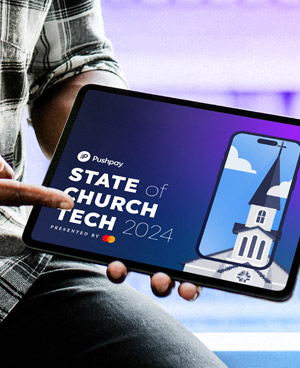2024 Church Giving Statistics & Trends To Care About
February 20, 2024 |
Giving is at the heart of any church community, and as we navigate through the year 2024, it’s clear that the landscape of church giving is as dynamic as ever.
But understanding church giving statistics and giving trends isn’t just about keeping up with the times—it’s about effectively managing and growing your church. When you’re in tune with the latest giving statistics, you’re better equipped to make informed decisions, develop strategic plans, and engage your congregation in a way that resonates.
Whether you’re an Executive Pastor looking to streamline processes and grow overall giving, or a Senior/Lead Pastor aiming to deepen personal connections with your congregation and expand your ministry, this guide is for you.
State of
Church Tech
Discover what church leaders like you are saying about their priorities, concerns, and expectations with church technology, today and for the future.

Current State of Church Giving
It’s crucial to understand the latest numbers around the state church giving because they provide vital insights into how congregations are financially supporting their churches.
Overview of 2024 Church Giving Statistics
In 2024, we’ve seen some encouraging statistics in church giving. A study by Parable noted that their church partners experienced an average increase of 17% in giving over the prior year, with many seeing double-digit growth. This trend is observable in churches all over the country, and indicates that church members are giving more generously.
What’s more, the frequency of donations has seen a significant uptick. More people are regularly contributing to their churches, demonstrating a strong commitment to their faith communities.
These (wonderful!) increases could be influenced by various factors, such as improved church management systems, more effective engagement strategies, and the adoption of digital giving solutions.
Churches that have embraced tools like ChurchStaq have reported growth in giving, as well as better engagement with their congregations. These solutions offer best-in-class systems and tools that support staff and volunteers, aid in financial stewardship, and help grow overall digital giving.
Emerging Trends in Church Giving
As you navigate through the dynamic landscape of church giving, it’s crucial to stay in tune with evolving best practices.
Rise of Digital and Mobile Giving
There’s a growing preference for digital and mobile giving among churchgoers. More and more people are choosing the convenience of online giving platforms and mobile apps to manage their donations and set up recurring gifts. It’s easy, flexible, and allows donors to contribute any time, anywhere.
This trend isn’t just about convenience, though. It’s also about engaging donors in a way that resonates with their digital lifestyles, leading to increased participation and generosity.
Impact of Social Media and Online Communities
Platforms like Facebook and Instagram have become a significant force in shaping giving behaviors. They provide a space for churches to engage with their communities, share inspiring stories, and encourage donations. By leveraging these online platforms, churches can reach a wider audience, fostering a sense of connection and belonging that motivates giving.
Generational Shifts in Giving Patterns
Understanding giving patterns across different age groups is essential for churches. Millennials and Gen Z, in particular, have unique preferences when it comes to giving. They value personalized and convenient giving options, often aligning their donations with their values and causes they care about. By adapting to these generational shifts, churches can offer giving options that resonate with younger churchgoers, encouraging them to contribute actively to their faith communities.
These trends are not just shaping the present but also the future of church giving. By understanding and embracing these trends, churches can engage their congregations more effectively, fostering a culture of generosity that supports their growth and mission.
Factors Influencing Church Giving in 2024
Understanding the broad scope of world trends can help churches adapt and thrive in a changing environment.
Economic Climate
When people are feeling financially secure, they’re often more willing to give. On the flip side, economic downturns can lead to tighter budgets and decreased giving. In 2024, we’re seeing a mixed bag. While some areas have rebounded from past economic challenges, others continue to face uncertainty. It’s important for churches to be aware of these realities and offer supportive resources for congregants navigating financial hardships.
Technological Advancements
New technologies are making it easier than ever for people to donate. Digital and mobile giving options have seen a surge in popularity, particularly among younger generations. Innovations like ChurchStaq have simplified the giving process, making it more accessible and convenient. This has led to increased participation and generosity, even among those who might not regularly attend in-person services.
Additionally, the use of data analytics is helping churches understand their congregants’ giving behaviors better and tailor their strategies accordingly. Tools that offer accurate metrics and reports are proving invaluable in this regard.
Adapting to Changes in Church Giving
There’s several proven strategies to help churches to stay ahead of shifting trends and engage different donor segments effectively.
Strategies for Churches
1. Embrace Online Giving Platforms: With the rise of digital and mobile giving, it’s important to provide convenient options for your congregants to donate. Services like Pushpay make this process seamless and user-friendly.
2. Leverage Social Media: Use digital marketing to reach a wider audience and promote giving opportunities. It’s a great way to connect with your community and inspire generosity.
3. Offer Multiple Giving Options: Cater to different preferences by offering various giving options. This could include recurring donations, mobile giving apps, or even traditional methods for those who prefer them.
4. Transparency is Key: Keep your congregants informed by sharing financial reports and updates. This transparency fosters trust and encourages more people to contribute.
5. Personalized Communication: Share stories that highlight the impact of their contributions. This not only inspires generosity but also strengthens your community’s bond.
Engaging Different Donor Segments
1. Young Adults: Connect by creating targeted programs and events. Utilize social media and digital platforms, which they’re likely already using.
2. Online Communities: Develop strategies to encourage online participation. This could involve livestreaming services, virtual events, or online volunteering opportunities.
3. Regular Donors: Don’t hesitate to show your appreciation, and keep them updated on the impact of their contributions. Consider personalized thank-you messages or special events.
4. New Donors: Welcome them warmly, and provide information about your church’s mission and how their contributions make a difference.
Looking Ahead: The Future of Church Giving
It’s clear that the arena of church giving is not static. It’s evolving, influenced by technology, generational shifts, and societal trends.
Predictions for Upcoming Years
1. Digital Transformation: Technology will likely play an even larger role in facilitating donations. With the rise of mobile and online platforms, we can expect these digital solutions to become even more popular among churchgoers.
2. Virtual and Hybrid Services: As churches continue to offer new forms of worship services, we might see a shift in giving patterns. Churches must be ready to adapt their strategies to engage both in-person and online congregants effectively.
3. Generational Shifts: As young people become more active in church communities, their preferences for digital and socially conscious giving will influence overall giving patterns.
4. Data-Driven Decisions: With advancements in technology, churches will have more data at their fingertips. This will enable them to make more informed decisions about outreach and engagement strategies.
Preparing for Future Trends
1. Embrace Technology: Investing in user-friendly online giving platforms can help increase donations and engage younger congregants. Tools like Pushpay and ChurchStaq can streamline this process, making it easier for your congregants to give.
2. Build Strong Relationships: Foster generosity by developing solid relationships with your donors. Personalized communication can go a long way in making your congregants feel valued and connected to your church’s mission.
3. Stay Flexible: The future is always uncertain, so it’s important to regularly evaluate and adapt your giving strategies based on changing trends. This will ensure your church is always ready to navigate whatever comes next.
The future of church giving is bright and full of potential. By staying adaptable and leveraging technology, your church can continue to foster a culture of generosity and support its mission.
Conclusion
It’s clear that churchgoers are moving towards digital and online giving methods, influenced by generational preferences and technological advancements. Virtual and hybrid services are becoming more prevalent, and data-driven decisions are increasingly important.
But remember, it’s not enough to read up on trends; you have to embrace them. Churches need to stay informed and adapt to these evolving patterns to ensure their sustained growth and impact. It’s about leveraging technology, building strong relationships with your congregants, and staying flexible to navigate whatever comes next.
And remember, tools like ChurchStaq are here to help you every step of the way. Let’s embrace the future of church giving together.
Featured Content
You May Also Like
